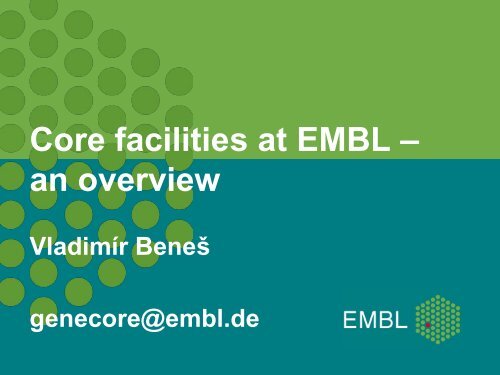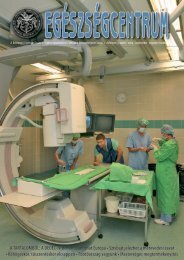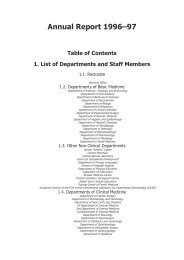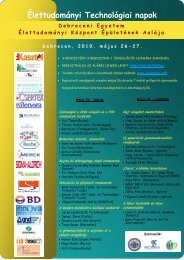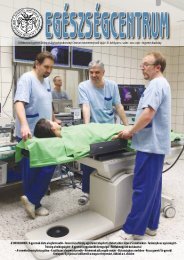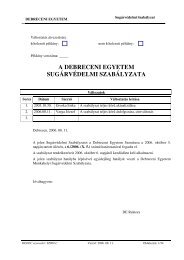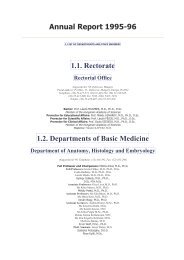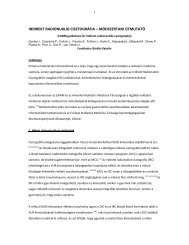Core facilities at EMBL â an overview - Molmedrex Project
Core facilities at EMBL â an overview - Molmedrex Project
Core facilities at EMBL â an overview - Molmedrex Project
- No tags were found...
You also want an ePaper? Increase the reach of your titles
YUMPU automatically turns print PDFs into web optimized ePapers that Google loves.
<strong>Core</strong> <strong>facilities</strong> <strong>at</strong> <strong>EMBL</strong> –<strong>an</strong> <strong>overview</strong>Vladimír Benešgenecore@embl.de
Research & <strong>Core</strong> Facilities @ <strong>EMBL</strong>
Research & <strong>Core</strong> Facilities <strong>at</strong> <strong>EMBL</strong>Principles of the <strong>Core</strong> Facilities’ oper<strong>at</strong>ion• Identified team for specific service work• The Head of CF is responsible for user s<strong>at</strong>isfaction• No own scientific projects but close interaction with theresearch community <strong>an</strong>d among individual CF• Work on service basis (no co-authorship required ordem<strong>an</strong>ded)• Fast & efficient services <strong>at</strong> the best possible price• All CFs have their user committees representing the Units• Access for academic collabor<strong>at</strong>ors/visitors, EMBO YIPs• Charging to recover the cost of consumables, mainten<strong>an</strong>ce
Introduction of new methodsReasons:• To improve quality <strong>an</strong>d efficiency of the services• To reduce the cost of the services• To test <strong>an</strong>d further develop new technologies or modifyexisting ones (collabor<strong>at</strong>ion with industry)• To react to users’ dem<strong>an</strong>d
<strong>Core</strong> Facilities <strong>at</strong> <strong>EMBL</strong>• Adv<strong>an</strong>ced Light Microscopy <strong>Core</strong> Facility• Electron Microscopy <strong>Core</strong> Facility• Flow Cytometry <strong>Core</strong> Facility• Protein Expression & Purific<strong>at</strong>ion <strong>Core</strong> Facility• Proteomics <strong>Core</strong> Facility• Genomics <strong>Core</strong> Facility• Chemical Biology <strong>Core</strong> Facility• Monoclonal Antibody <strong>Core</strong> Facility
Gene<strong>Core</strong>: Mission St<strong>at</strong>ement• In-house genomics service centre equipped with thest<strong>at</strong>e-of-the art equipment required for projects infunctional genomics• Highly competent, dedic<strong>at</strong>ed staff (“intelligent service”)• Consistent perform<strong>an</strong>ce (proficiency testing)• Stringent adherence to quality• New applic<strong>at</strong>ions offered if a sufficient user-base exists• “Missing” applic<strong>at</strong>ions complemented with other CFnearby (in DKFZ, for example)
Unlocking the genomeCelniker et al., N<strong>at</strong>ure 2009
Gene<strong>Core</strong> ServicesMicroarrays (commercial, in-house spotted):• Expression <strong>an</strong>alysis (mostly Affymetrix, some Agilent, in-house1400MycoArray)1200• Occup<strong>an</strong>cy profiling with tiling arrays (Affymetrix)1000• microRNA <strong>an</strong>alysis800(in-house LNA-based miChip)600• Molecular bar-coding, aCGH400Support for microarray 200 d<strong>at</strong>a <strong>an</strong>alysis: GeneSpring, Genom<strong>at</strong>ix,Partek, GeneGo02006 2007 2008 2009expressionAgilent sc<strong>an</strong>ner upgraded to 2 µm resolution => suitable for veryhighdensity arrays (1-2 mil. fe<strong>at</strong>ures, Agilent, Nimblegen)tiling
Gene<strong>Core</strong> ServicesLiquid h<strong>an</strong>dling robotics, autom<strong>at</strong>ion support<strong>Project</strong>s based on 96- <strong>an</strong>d 384-well form<strong>at</strong>• Plasmid DNA purific<strong>at</strong>ion• PCR set up & purific<strong>at</strong>ion• Replic<strong>at</strong>ion & consolid<strong>at</strong>ion (cherry picking) oflibraries• Prepar<strong>at</strong>ion of spotting pl<strong>at</strong>es (re-arraying)• Development of new applic<strong>at</strong>ions & autom<strong>at</strong>ionof protocols comp<strong>at</strong>ible with devices
“Samples”:Gene<strong>Core</strong> Services• Sequencing (plasmids, PCR fragments, BACs),winding down=> outsourced to GATC Konst<strong>an</strong>z• Fragment <strong>an</strong>alysis (genotyping)• qPCR miRNA assays• Bio<strong>an</strong>alyzer
Gene<strong>Core</strong> ServicesComplete support & access to instruments:• qPCR• N<strong>an</strong>oDrop, PCR cyclers, microarray sc<strong>an</strong>ners,hybridiz<strong>at</strong>ion ovens, high capacity SpeedVac,HydroShear, Covaris etc.
Other activitiesCooper<strong>at</strong>ion with ALMF to prepare arrays forautom<strong>at</strong>ed high-content microscopy (cellbasedsiRNA assays in LabTek chambers)Training courses on functional genomicsmethods & their d<strong>at</strong>a <strong>an</strong>alysis for <strong>EMBL</strong> <strong>an</strong>doutsideProficiency testing of the Gene<strong>Core</strong> staffcDNA libraries (drosophila, mouse, medaka,nem<strong>at</strong>ode)…
Regul<strong>at</strong>ion of ERα responsive genesHOCH3 OHE2HMTsHATs,HDACsMedi<strong>at</strong>orTRANSCRIPTION:GX microarrays,qPCR GX <strong>an</strong>alysis,miRNA profiling,SAGELOCATION ANALYSIS:ChIP-on-chip, ChIP-qPCRD<strong>at</strong>a <strong>an</strong>alysisNuclearreceptorNucleosomesEPIGENETICS:“Bisulfite” sequencingDNMTsTarget genesBy courtesy of G. Reid& S. K<strong>an</strong>gaspeska
New-gen sequencing on SolexaSt<strong>at</strong>e-of-the-m<strong>at</strong>ter:Hardware – 3 GAIIx with paired-end modulesSoftware, IT infrastructure – d<strong>at</strong>a processing pipeline inplace but continuously upd<strong>at</strong>ed from the Illumina side- d<strong>at</strong>a storage m<strong>an</strong>agement with IT ServicesPrepar<strong>at</strong>ion of seq libraries – under reasonable control,almost all sample types tested, Covaris, HydroShearD<strong>at</strong>a <strong>an</strong>alysis – in-house SW solutions, Genom<strong>at</strong>ix GenomeAnalyzer & Mapper, DNAStar Ngen, collabor<strong>at</strong>ion withEBI
<strong>EMBL</strong> Solexas• ~180 million reads per a flow-cell (8 l<strong>an</strong>es)• >7 Gbp per single read flow-cell (36 bases)• >14 Gbp per PE flow-cell (36 bases)• >2 Gbp/day (capillary sequencer max. 320 kb/day)• 2,5 day single read run, 5 day PE run on Solexa (36 bases)• Supported reading length: 75 bases, 100 coming• Sequencing libraries 200-500 bp, 3-5 kb “insert” length(m<strong>at</strong>e-pair), multiplexing• Full sample processing (library prepar<strong>at</strong>ion, clustering,sequencing): ~950 €/sample/l<strong>an</strong>e (single-read, 36 bases)
Illumina-Solexa workflow1) Library prepar<strong>at</strong>ionSingle readPaired-end read36-100 basesBarcoding2) Cluster gener<strong>at</strong>ion ona flow cell3) Sequencing & imaging4) D<strong>at</strong>a processing & <strong>an</strong>alysis
Cluster gener<strong>at</strong>ionPrepare DNAfragmentsLig<strong>at</strong>e adaptersAttach single molecules to surfaceAmplify to form clusters100 µmR<strong>an</strong>dom array of clusters~1,000 molecules per ~ 1 µm 2 cluster~180,000 clusters per tile~22 million clusters/l<strong>an</strong>e=>~8 Gb/flow cell
MPS spaceKahveji<strong>an</strong>, N<strong>at</strong> Biotech 2008
Applic<strong>at</strong>ions <strong>at</strong> <strong>EMBL</strong>• Whole-genome <strong>an</strong>alyses of tr<strong>an</strong>scriptome,miRNome & occup<strong>an</strong>cy profiling• Identific<strong>at</strong>ion of DNA <strong>an</strong>d RNA protein binding sites(ChIP-Seq, CLIP-Seq)• Identific<strong>at</strong>ion of methyl<strong>at</strong>ion p<strong>at</strong>terns (Methyl-Seq)• Identific<strong>at</strong>ion of small ncRNA (miRNA) sequences• Digital gene expression profiling (RNA-Seq)• Whole genome sequencing• De novo sequencing <strong>an</strong>d re-sequencing (pairedendedreads)• Structural vari<strong>at</strong>ion of genomes – CNV, SNP, in/del
D<strong>at</strong>a <strong>an</strong>alysis –sequence census approach3 types of inform<strong>at</strong>ion:• Sequence polymorphism in the templ<strong>at</strong>e• Qu<strong>an</strong>tit<strong>at</strong>ive measure (abund<strong>an</strong>ce of reads)• Covered regions reveal the internalstructure of the templ<strong>at</strong>e (exon/introns, NAproteinbinding sites)Morozova & Marra, Genomics (2008)
Challenges• ChIP-Seq <strong>an</strong>d RNA-Seq still requires rel<strong>at</strong>ively high startingamount of IP or total RNA• Output is not yet qu<strong>an</strong>tit<strong>at</strong>ive enough~10 million reads to qu<strong>an</strong>tify ~ 80 %of tr<strong>an</strong>scripts, ~200 million reads to qu<strong>an</strong>tifysplicing levels for ~80 % of tr<strong>an</strong>scriptsBlencowe, Genes & Development (2009)• Tools for qu<strong>an</strong>tific<strong>at</strong>ion of sequencing library to determinenumber of fragments th<strong>at</strong> c<strong>an</strong> gener<strong>at</strong>e clusters suboptimal• Reduction of base composition bias in produced d<strong>at</strong>a• D<strong>at</strong>a <strong>an</strong>alysis
Experimental designMorereadsis import<strong>an</strong>tLargeinsertSmallinsertPaired endMassively parallelsequencingLongerreadsMoresamplesArray-basedenrichmentHighercoverageSolution-basedenrichmentBy courtesy of J. Castle
AcknowledgementRichard CarmoucheJürgen Zimmerm<strong>an</strong>nJens StolteJos de GraafSabine SchmidtTomi Bähr-IvacevicDavid IbbersonTobias RauschJon<strong>at</strong>hon Blake
http://www.genecore.embl.de


